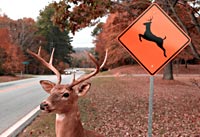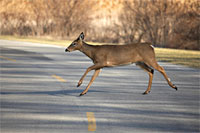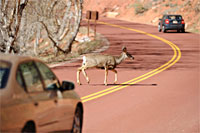Just a short reminder to check in with your local street coordinator and get out to celebrate National Night Out with your neighbors on August 6th! The West Loop of Jan Drive group has had to cancel their plans for this year, but Marble and Rampart should be out in full force and showing their local neighborhood pride. Stop by tomorrow evening and cheer their supportive street groups on :)
Deer Sightings
We have had several sightings of a doe and fawns on and near Lincoln Avenue, between Manzanita and Barrett Road.
View Larger Map
Taken from a GEICO website, here is some excellent information on sharing the road with deer and keeping you and your family safe. http://www.geico.com/information/publications/newsletter/2009/deer-safety/
Most importantly, drive SLOWLY.
Deer Safety: Tips for Avoiding a Collision
 By Dawn McCaslin
By Dawn McCaslin
Like a scene straight out of a sports car commercial, you're driving along a winding road in the dead of night, the eerie glow from your headlights meeting the narrow asphalt, when suddenly, two green eyes flash in the darkness ahead – and a deer steps onto the roadway.
Unlike the television ad when the driver swerves wildly around the animal and then speeds off carelessly into the blackness, encountering a deer while you're on the road can be dangerous and scary. According to the National Highway Traffic Safety Administration (NHTSA), large animal-vehicle collisions resulted in an average of 187 fatalities in recent years.
So, what can you do to stay safe during deer season?
Read on to learn the latest statistics and a few tips for making your drive through deer country as safe as possible.
 Deer Statistics
Deer Statistics
- Dawn and dusk are the times you are most likely to encounter deer along the roadside.
- Deer breeding season runs from October through early January, and during this time they are highly active and on the move. This is when deer-vehicle collisions are at their peak.
- Though deer may wander into suburban neighborhoods, they are most frequently found on the outskirts of town and in heavily wooded areas.
- As pack animals, deer almost never travel alone. If you see one deer, you can bet that there are others nearby.
Preventive Techniques
- The two most important ways to avoid a deer-vehicle collision are: slow down and SLOW DOWN. If you are driving through an area known for high deer populations, slow down and observe the speed limit. The more conservative you are with your speed, the more time you will have to brake if an animal darts into your path.
- Always wear a seatbelt. The most severe injuries in deer-vehicle collisions usually result from failure to use a seatbelt.
- Watch for the shine of eyes along the roadside and immediately begin to slow.
- Use your high beams whenever the road is free of oncoming traffic. This will increase your visibility and give you more time to react.
- Deer can become mesmerized by steady, bright lights so if you see one frozen on the road, slow down and flash your lights. Some experts recommend one long blast of the horn to scare them out of the road, as well.
- Pay close attention to caution signs indicating deer or other large animals. These signs are specifically placed in high-traffic areas where road crossings are frequent.
- If you're on a multi-lane road, drive in the center lane to give as much space to grazing deer as possible.
Encountering a Deer
- Never swerve to avoid a deer in the road. Swerving can confuse the deer on where to run. Swerving can also cause a head-on collision with oncoming vehicles, take you off the roadway into a tree or a ditch, and greatly increase the chances of serious injuries.
- Deer are unpredictable creatures, and one that is calmly standing by the side of the road may suddenly leap into the roadway without warning. Slowing down when you spot a deer is the best way to avoid a collision. However, if one does move into your path, maintain control and do your best to brake and give the deer time to get out of your way.
- Don't rely on hood whistles or other devices designed to scare off deer. These have not been proven to work.
- If you do collide with a deer (or large animal), call emergency services if injuries are involved, or the local police if no one is injured, but damage has been caused to your property or someone else's. Never touch an animal that is in the roadway. Report the incident to your insurance company as soon as possible.
Unlike that fictional driver from the car commercial, knowing what to do when you encounter a large animal on or near the roadway can be a life-saver. Keeping calm and driving smart improve your chances of avoiding a collision and staying safe on the road. Safe travels!




No comments:
Post a Comment
Thank you so much for taking the time to leave us a comment. We will do our best to respond in a timely manner, and ask that you contact the Sac Sheriff Dept. for immediate safety concerns of any type at 911 or 874-5115 (non-emergency). Be alert, be aware, and stay safe!